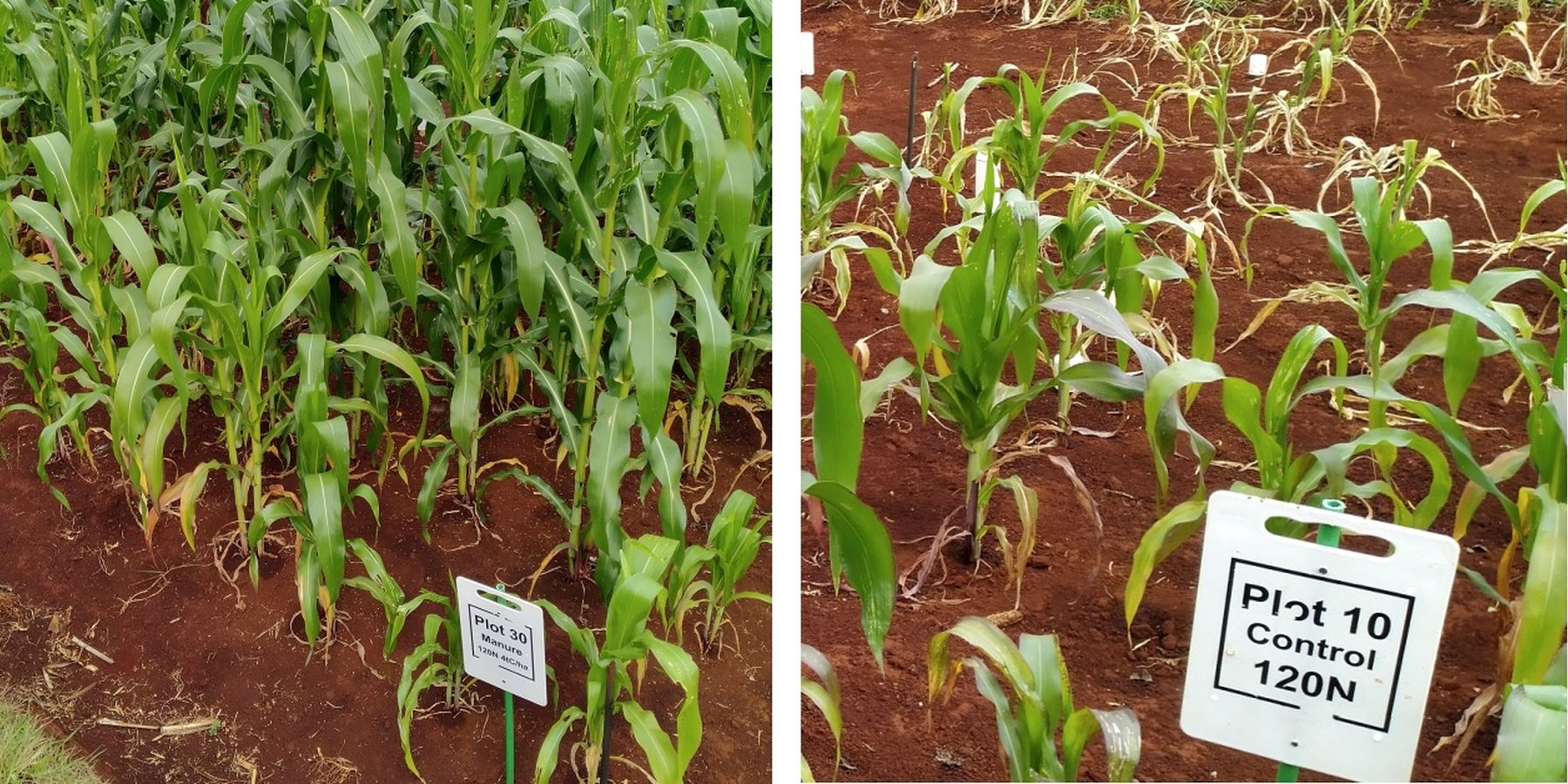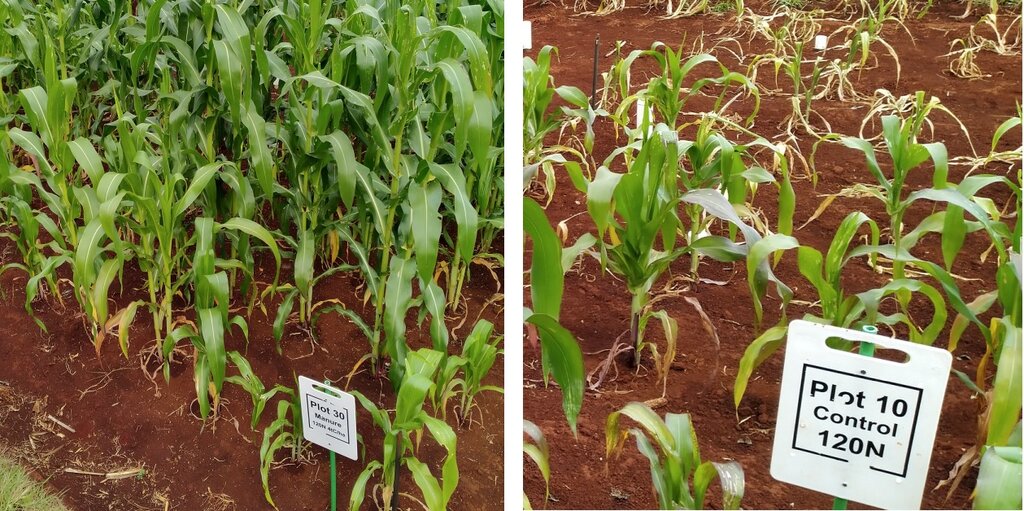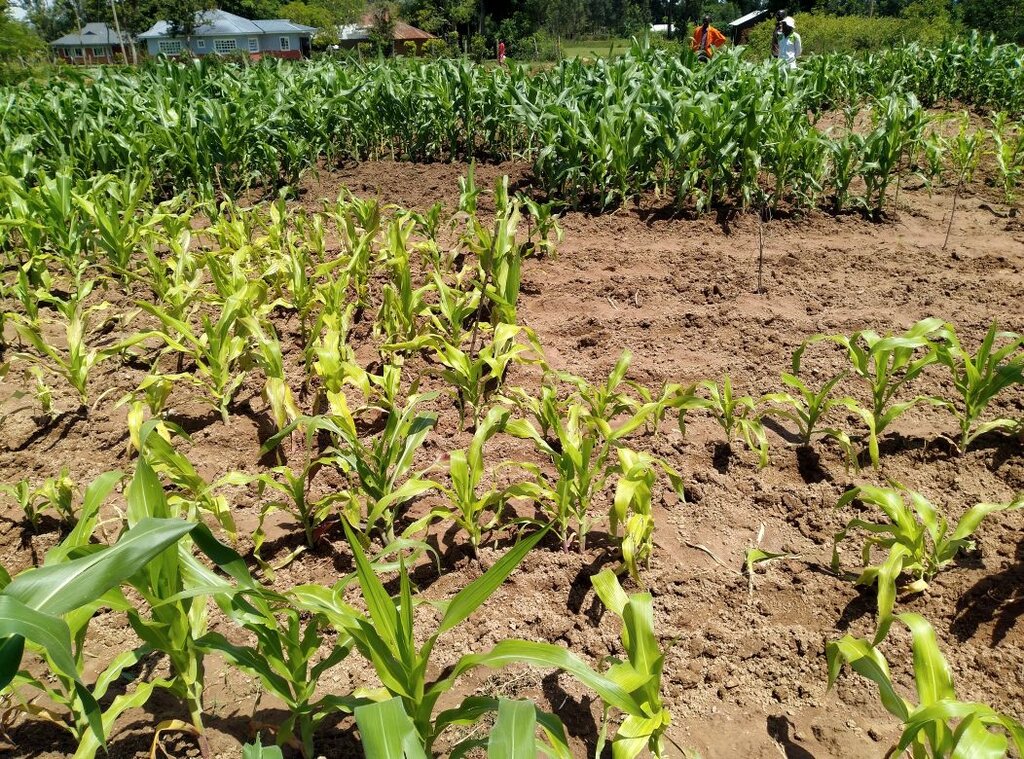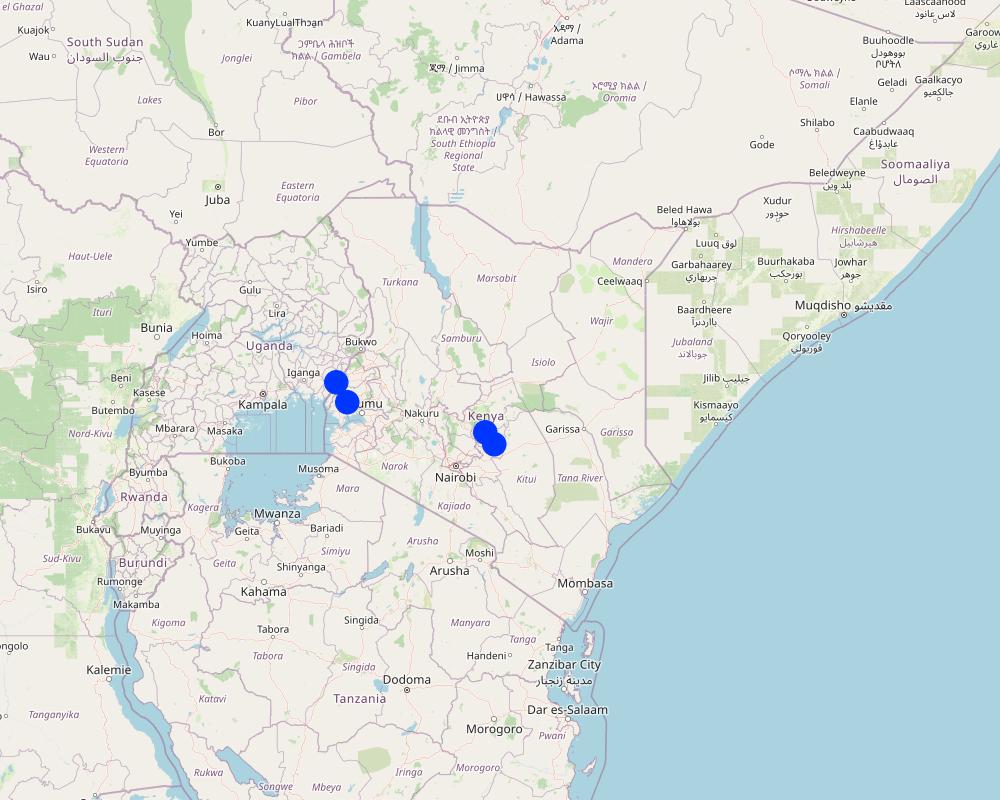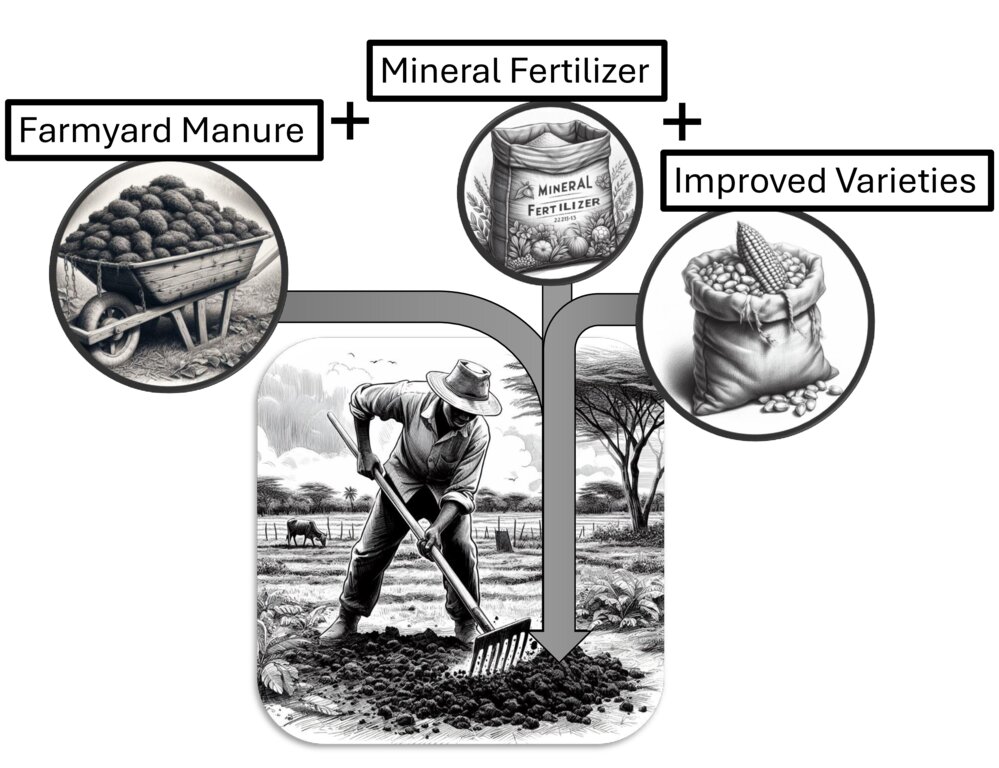Integrated soil fertility management (ISFM) [เคนยา]
- ผู้สร้างสรรค์:
- การอัพเดท:
- ผู้รวบรวม: Moritz Laub
- ผู้เรียบเรียง: –
- ผู้ตรวจสอบ: William Critchley, Rima Mekdaschi Studer
Machanganyiko ya mbolea ya ngombe na fertilizer
technologies_7121 - เคนยา
ดูส่วนย่อย
ขยายทั้งหมด ย่อทั้งหมด1. ข้อมูลทั่วไป
1.2 รายละเอียดที่ติดต่อได้ของผู้รวบรวมและองค์กรที่เกี่ยวข้องในการประเมินและการจัดเตรียมทำเอกสารของเทคโนโลยี
วิทยากรหลัก
ผู้เชี่ยวชาญ SLM:
Laub Moritz
ETH Zurich
สวิตเซอร์แลนด์
ผู้เชี่ยวชาญ SLM:
Bernhard Vanlauwe
International Institute of Tropical Agriculture
เคนยา
ผู้เชี่ยวชาญ SLM:
Six Johan
ETH Zurich
สวิตเซอร์แลนด์
ผู้เชี่ยวชาญ SLM:
Mucheru-Muna Monicah
Kenyatta University
เคนยา
ผู้เชี่ยวชาญ SLM:
Yegon Rebecca
University of Embu
เคนยา
ผู้ใช้ที่ดิน:
Waswa Wycliffe
International Institute of Tropical Agriculture
เคนยา
ผู้ใช้ที่ดิน:
Kiragu Silas
University of Embu
เคนยา
ชื่อของโครงการซึ่งอำนวยความสะดวกในการทำเอกสารหรือการประเมินเทคโนโลยี (ถ้าเกี่ยวข้อง)
Land Use Based Mitigation for Resilient Climate Pathways (LANDMARC)ชื่อขององค์กรซึ่งอำนวยความสะดวกในการทำเอกสารหรือการประเมินเทคโนโลยี (ถ้าเกี่ยวข้อง)
ETH-Zürich (ETH-Zürich) - สวิตเซอร์แลนด์1.3 เงื่อนไขการใช้ข้อมูลที่ได้บันทึกผ่านทาง WOCAT
ผู้รวบรวมและวิทยากรหลักยอมรับเงื่อนไขเกี่ยวกับการใช้ข้อมูลที่ถูกบันทึกผ่านทาง WOCAT:
ใช่
1.4 การเปิดเผยเรื่องความยั่งยืนของเทคโนโลยีที่ได้อธิบายไว้
เทคโนโลยีที่ได้อธิบายไว้นี้เป็นปัญหาของความเสื่อมโทรมโทรมของที่ดินหรือไม่ จึงไม่ได้รับการยอมรับว่าเป็นเทคโนโลยีเพื่อการจัดการที่ดินอย่างยั่งยืน:
ไม่ใช่
แสดงความคิดเห็น:
ISFM offers reduced degradation, or even avoided degradation of soils compared to the locally most used alternative maize growing systems, traditional low-input maize production and high input maize production with only mineral N fertilizer. As demonstrated in four long-term trials, both of these systems usually come at the cost of soil fertility loss.
2. การอธิบายลักษณะของเทคโนโลยี SLM
2.1 การอธิบายแบบสั้น ๆ ของเทคโนโลยี
คำจำกัดความของเทคโนโลยี:
Integrated soil fertility management constitutes a group of management practices aimed at increasing soil fertility and crop productivity with the local context in mind. These practices integrate the use of organic inputs, fertilizers, and better quality seeds with all inputs managed following good farming practices.
2.2 การอธิบายแบบละเอียดของเทคโนโลยี
คำอธิบาย:
Integrated Soil Fertility Management (ISFM) is applied in arable cropping systems. In this example it was rigorously tested in maize cropping systems in Kenya. The main features of ISFM are the integration of organic inputs to increase or maintain soil fertility and provide a background of nutrient release, with mineral fertilizers to meet peak plant demand together with high quality seeds that can utilize the inputs well. The main objectives are to increase crop yield while maintaining or improving soil fertility. This is important because four long-term trials in Kenya have shown that long-term maize yields decline in both low-input systems and systems with high mineral N inputs but without organic inputs. In contrast, systems with farmyard manure application maintained yields over two decades and maintained significantly higher soil fertility. It has also been shown that the input of organic resources with a low C:N ratio, such as farmyard manure, is more effective in maintaining yields and soil fertility than mineral fertilizer inputs. Thus, the main inputs are organic resources with a low C:N ratio (ideally farmyard manure, but green manures such as Tithonia sp. or Calliandra sp. can also be used), while mineral fertilizers and high quality seeds are also needed. A major activity is the incorporation of organic resources before planting, which requires additional labour. ISFM offers significantly higher yields, and yield maintenance over time, while maintaining or increasing soil fertility. However, it is important to note that the advantage of ISFM over mineral fertilizer use becomes apparent only in the long term (e.g., after 5 to 10 years of continuous cropping). This is because mineral fertilizer inputs may initially mask the loss of soil fertility. This long-term perspective has to be kept in mind when considering the main perceived disadvantage of ISFM - that is the need for manure input and labour for its incorporation, which does not immediately result in higher yields compared to mineral fertilizer application alone.
2.3 รูปภาพของเทคโนโลยี
2.5 ประเทศภูมิภาค หรือสถานที่ตั้งที่เทคโนโลยีได้นำไปใช้และได้รับการครอบคลุมโดยการประเมินนี้
ประเทศ:
เคนยา
ภูมิภาค/รัฐ/จังหวัด:
Embu County; Siaya County; Busia County
ข้อมูลจำเพาะเพิ่มเติมของสถานที่ตั้ง :
Embu city; Mavuria; close to Siaya; close to Busia
ระบุการกระจายตัวของเทคโนโลยี:
- ใช้ ณ จุดที่เฉพาะเจาะจงหรือเน้นไปยังบริเวณพื้นที่ขนาดเล็ก
Is/are the technology site(s) located in a permanently protected area?
ไม่ใช่
แสดงความคิดเห็น:
The locations display the position of the long-term trials in which ISFM was tested
Map
×2.6 วันที่การดำเนินการ
ระบุปีที่ใช้:
2002
2.7 คำแนะนำของเทคโนโลยี
ให้ระบุว่าเทคโนโลยีถูกแนะนำเข้ามาอย่างไร:
- ในช่วงการทดลองหรือการทำวิจัย
3. การจัดประเภทของเทคโนโลยี SLM
3.1 วัตถุประสงค์หลักของเทคโนโลยี
- ปรับปรุงการผลิตให้ดีขึ้น
- ลด ป้องกัน ฟื้นฟู การเสื่อมโทรมของที่ดิน
- ปรับตัวเข้ากับการเปลี่ยนแปลงภูมิอากาศของโลก สภาพภูมิอากาศที่รุนแรงและผลกระทบ
- สร้างผลกระทบทางด้านเศรษฐกิจที่เป็นประโยชน์
3.2 ประเภทของการใช้ที่ดินในปัจจุบันที่ได้นำเทคโนโลยีไปใช้
Land use mixed within the same land unit:
ไม่ใช่

พื้นที่ปลูกพืช
- การปลูกพืชล้มลุกอายุปีเดียว
Annual cropping - Specify crops:
- cereals - maize
- cereals - millet
- cereals - sorghum
Annual cropping system:
Continuous maize/sorghum/millet
จำนวนของฤดูเพาะปลูกต่อปี:
- 2
Is intercropping practiced?
ไม่ใช่
Is crop rotation practiced?
ไม่ใช่

อื่น ๆ
ระบุ:
Mixed crop-livestock farms
ข้อสังเกต:
Manure can come from animals that are grazed or from animals kept in a zero-grazing system.
3.3 Has land use changed due to the implementation of the Technology?
Has land use changed due to the implementation of the Technology?
- No (Continue with question 3.4)
3.4 การใช้น้ำ
การใช้น้ำของที่ดินที่มีการใช้เทคโนโลยีอยู่:
- จากน้ำฝน
3.5 กลุ่ม SLM ที่ตรงกับเทคโนโลยีนี้
- การจัดการปลูกพืชร่วมกับปศุสัตว์
- การจัดการความอุดมสมบรูณ์ของดินแบบผสมผสาน
- การปรับปรุงพันธุ์พืชหรือพันธุ์สัตว์ต่าง ๆ
3.6 มาตรการ SLM ที่ประกอบกันเป็นเทคโนโลยี

มาตรการจัดการพืช
- A2: อินทรียวัตถุในดิน/ความอุดมสมบูรณ์ในดิน
- A5: การจัดการเมล็ดพันธุ์ การปรับปรุงพันธุ์
- A6: Residue management
A6: Specify residue management:
A 6.2: grazed
3.7 รูปแบบหลักของการเสื่อมโทรมของที่ดินที่ได้รับการแก้ไขโดยเทคโนโลยี

การเสื่อมโทรมของดินทางด้านเคมี
- Cn (Fertility decline): ความอุดมสมบูรณ์และปริมาณอินทรียวัตถุในดินถูกทำให้ลดลงไป (ไม่ได้เกิดจากสาเหตุการกัดกร่อน)

การเสื่อมโทรมของดินทางด้านชีวภาพ
- Bl (Loss of soil life): การสูญเสียสิ่งมีชีวิตในดิน
3.8 การป้องกัน การลดลง หรือการฟื้นฟูความเสื่อมโทรมของที่ดิน
ระบุเป้าหมายของเทคโนโลยีกับความเสื่อมโทรมของที่ดิน:
- ป้องกันความเสื่อมโทรมของที่ดิน
- ลดความเสื่อมโทรมของดิน
4. ข้อมูลจำเพาะด้านเทคนิค กิจกรรมการนำไปปฏิบัติใช้ ปัจจัยนำเข้า และค่าใช้จ่าย
4.1 แบบแปลนทางเทคนิคของเทคโนโลยี
ข้อมูลจำเพาะด้านเทคนิค (แบบแปลนทางเทคนิคของเทคโนโลยี):
Organic resources are distributed equally across the field and then incorporated (usually by hand hoe). Full ISFM integrates this with improved maize varieties and small doses of mineral fertilizer.
ผู้เขียน:
Moritz Laub
วันที่:
07/05/2024
4.2 ข้อมูลทั่วไปเกี่ยวกับการคำนวณปัจจัยนำเข้าและค่าใช้จ่าย
ให้ระบุว่าค่าใช้จ่ายและปัจจัยนำเข้าได้รับการคำนวณอย่างไร:
- ต่อพื้นที่ที่ใช้เทคโนโลยี
ระบุขนาดและหน่วยพื้นที่:
hectare
อื่นๆ หรือสกุลเงินประจำชาติ (ระบุ):
KSH
If relevant, indicate exchange rate from USD to local currency (e.g. 1 USD = 79.9 Brazilian Real): 1 USD =:
135.0
ระบุค่าเฉลี่ยของค่าจ้างในการจ้างแรงงานต่อวัน:
500
4.3 กิจกรรมเพื่อการจัดตั้ง
| กิจกรรม | Timing (season) | |
|---|---|---|
| 1. | Training on (green/farmyard) manure handling and incorporation | any |
4.4 ค่าใช้จ่ายของปัจจัยนำเข้าที่จำเป็นสำหรับการจัดตั้ง
| ปัจจัยนำเข้า | หน่วย | ปริมาณ | ค่าใช้จ่ายต่อหน่วย | ค่าใช้จ่ายทั้งหมดต่อปัจจัยนำเข้า | %ของค่าใช้จ่ายที่ก่อให้เกิดขึ้นโดยผู้ใช้ที่ดิน | |
|---|---|---|---|---|---|---|
| อื่น ๆ | Training on ISFM and organic resource management |
ถ้าผู้ใช้ที่ดินรับภาระน้อยกว่า 100% ของค่าใช้จ่าย ให้ระบุว่าใครเป็นผู้รับผิดชอบส่วนที่เหลือ:
One or two days of workshop costs. Cost of exchanges with extension agents (mainly time)
4.5 การบำรุงรักษาสภาพหรือกิจกรรมที่เกิดขึ้นเป็นประจำ
| กิจกรรม | ช่วงระยะเวลา/ความถี่ | |
|---|---|---|
| 1. | Organic resource preparation (e.g. chopping of green manure, farmyard manure management) | Before planting |
| 2. | Organic resource application and incorporation to about 15 cm soil depth | Before planting |
| 3. | Application of mineral fertilizer | During peak demand |
4.6 ค่าใช้จ่ายของปัจจัยนำเข้าและกิจกรรมที่เกิดขึ้นเป็นประจำที่ต้องการการบำรุงรักษา (ต่อปี)
| ปัจจัยนำเข้า | หน่วย | ปริมาณ | ค่าใช้จ่ายต่อหน่วย | ค่าใช้จ่ายทั้งหมดต่อปัจจัยนำเข้า | %ของค่าใช้จ่ายที่ก่อให้เกิดขึ้นโดยผู้ใช้ที่ดิน | |
|---|---|---|---|---|---|---|
| แรงงาน | Manual labor for manure incorporation | labor days per ha | 10.0 | 500.0 | 5000.0 | |
| วัสดุด้านพืช | Hybrid maize seeds | kg per ha | 25.0 | 450.0 | 11250.0 | |
| ปุ๋ยและสารฆ่า/ยับยั้งการเจริญเติบโตของสิ่งมีชีวิต (ไบโอไซด์) | Manure (green/farmyard) per ha and season | t dry matter | 2.0 | 5500.0 | 11000.0 | |
| ปุ๋ยและสารฆ่า/ยับยั้งการเจริญเติบโตของสิ่งมีชีวิต (ไบโอไซด์) | Mineral N (estimate ideal input) | kg per ha and season | 30.0 | 300.0 | 9000.0 | |
| ค่าใช้จ่ายทั้งหมดของการบำรุงรักษาสภาพเทคโนโลยี | 36250.0 | |||||
| Total costs for maintenance of the Technology in USD | 268.52 | |||||
แสดงความคิดเห็น:
Prices of May 2024. The cost of manure is highly variable locally (estimated to be around 2000 KSH per t dry matter in western and up to 9000 KSH per t dry matter in central Kenya; we used the mean value of these). In mixed crop-livestock systems, the manure may be sourced from the own farm, in which case the cost of ISFM may be reduced tremendously.
4.7 ปัจจัยสำคัญที่สุดที่มีผลกระทบต่อค่าใช้จ่าย
ปัจจัยสำคัญที่สุดที่มีผลกระทบต่อค่าใช้จ่ายต่างๆ:
Local labor prices. Local availability of livestock. Local fertilizer and seed prices.
5. สิ่งแวดล้อมทางธรรมชาติและของมนุษย์
5.1 ภูมิอากาศ
ฝนประจำปี
- < 250 ม.ม.
- 251-500 ม.ม.
- 501-750 ม.ม.
- 751-1,000 ม.ม.
- 1,001-1,500 ม.ม.
- 1,501-2,000 ม.ม.
- 2,001-3,000 ม.ม.
- 3,001-4,000 ม.ม.
- > 4,000 ม.ม.
ข้อมูลจำเพาะ/ความคิดเห็นเรื่องปริมาณน้ำฝน:
ISFM can likely be used wherever it is feasible to grow maize. It proved most effective in high-rainfall areas > 1200 mm (for maize), because in areas where rainfall was limiting (e.g., Machanga site), the plants were mainly water limited and could not make good use of the additional soil fertility.
เขตภูมิอากาศเกษตร
- ชื้น
5.2 สภาพภูมิประเทศ
ค่าเฉลี่ยความลาดชัน:
- ราบเรียบ (0-2%)
- ลาดที่ไม่ชัน (3-5%)
- ปานกลาง (6-10%)
- เป็นลูกคลื่น (11-15%)
- เป็นเนิน (16-30%)
- ชัน (31-60%)
- ชันมาก (>60%)
ธรณีสัณฐาน:
- ที่ราบสูง/ที่ราบ
- สันเขา
- ไหล่เขา
- ไหล่เนินเขา
- ตีนเนิน
- หุบเขา
ระดับความสูง:
- 0-100 เมตร
- 101-500 เมตร
- 501-1,000 เมตร
- 1,001-1,500 เมตร
- 1,501-2,000 เมตร
- 2,001-2,500 เมตร
- 2,501-3,000 เมตร
- 3,001-4,000 เมตร
- > 4,000 เมตร
ให้ระบุถ้าเทคโนโลยีได้ถูกนำไปใช้:
- ไม่เกี่ยวข้อง
5.3 ดิน
ค่าเฉลี่ยความลึกของดิน:
- ตื้นมาก (0-20 ซ.ม.)
- ตื้น (21-50 ซ.ม.)
- ลึกปานกลาง (51-80 ซ.ม.)
- ลึก (81-120 ซ.ม.)
- ลึกมาก (>120 ซ.ม.)
เนื้อดิน (ดินชั้นบน):
- ปานกลาง (ดินร่วน ทรายแป้ง)
- ละเอียด/หนัก (ดินเหนียว)
เนื้อดินล่าง (> 20 ซ.ม.ต่ำจากผิวดิน):
- ปานกลาง (ดินร่วน ทรายแป้ง)
- ละเอียด/หนัก (ดินเหนียว)
อินทรียวัตถุในดิน:
- ปานกลาง (1-3%)
- ต่ำ (<1%)
(ถ้ามี) ให้แนบคำอธิบายเรื่องดินแบบเต็มหรือระบุข้อมูลที่มีอยู่ เช่น ชนิดของดิน ค่า pH ของดินหรือความเป็นกรดของดิน ความสามารถในการแลกเปลี่ยนประจุบวก ไนโตรเจน ความเค็ม เป็นต้น:
Detailed descriptions can be found here: https://www.sciencedirect.com/science/article/pii/S0378429022003598
and here: https://soil.copernicus.org/articles/9/301/2023/
5.4 ความเป็นประโยชน์และคุณภาพของน้ำ
น้ำไหลบ่าที่ผิวดิน:
ปานกลาง
คุณภาพน้ำ (ที่ยังไม่ได้บำบัด):
เป็นน้ำใช้เพื่อการเกษตรเท่านั้น (การชลประทาน)
Water quality refers to:
surface water
ความเค็มของน้ำเป็นปัญหาหรือไม่:
ไม่ใช่
กำลังเกิดน้ำท่วมในพื้นที่หรือไม่:
ไม่ใช่
5.5 ความหลากหลายทางชีวภาพ
ความหลากหลายทางชนิดพันธุ์:
- ปานกลาง
ความหลากหลายของแหล่งที่อยู่:
- ปานกลาง
5.6 ลักษณะของผู้ใช้ที่ดินที่นำเทคโนโลยีไปปฏิบัติใช้
อยู่กับที่หรือเร่ร่อน:
- อยู่กับที่
แนวทางการตลาดของระบบการผลิต:
- mixed (subsistence/ commercial)
รายได้ที่มาจากนอกฟาร์ม:
- < 10% ของรายได้ทั้งหมด
ระดับของความมั่งคั่งโดยเปรียบเทียบ:
- จน
- พอมีพอกิน
เป็นรายบุคคล/ครัวเรือน:
- เป็นรายบุคคล/ครัวเรือน
ระดับของการใช้เครื่องจักรกล:
- งานที่ใช้แรงกาย
- การใช้กำลังจากสัตว์
อายุของผู้ใช้ที่ดิน:
- วัยกลางคน
5.7 Average area of land used by land users applying the Technology
- < 0.5 เฮกตาร์
- 0.5-1 เฮกตาร์
- 1-2 เฮกตาร์
- 2-5 เฮกตาร์
- 5-15 เฮกตาร์
- 15-50 เฮกตาร์
- 50-100 เฮกตาร์
- 100-500 เฮกตาร์
- 500-1,000 เฮกตาร์
- 1,000-10,000 เฮกตาร์
- >10,000 เฮกตาร์
พิจารณาว่าเป็นขนาดเล็ก กลาง หรือขนาดใหญ่ (ซึ่งอ้างอิงถึงบริบทระดับท้องถิ่น):
- ขนาดกลาง
5.8 กรรมสิทธิ์ในที่ดิน สิทธิในการใช้ที่ดินและสิทธิในการใช้น้ำ
กรรมสิทธิ์ในที่ดิน:
- รายบุคคล ไม่ได้รับสิทธิครอบครอง
- รายบุคคล ได้รับสิทธิครอบครอง
สิทธิในการใช้ที่ดิน:
- รายบุคคล
5.9 การเข้าถึงบริการและโครงสร้างพื้นฐาน
สุขภาพ:
- จน
- ปานกลาง
- ดี
การศึกษา:
- จน
- ปานกลาง
- ดี
ความช่วยเหลือทางด้านเทคนิค:
- จน
- ปานกลาง
- ดี
การจ้างงาน (เช่น ภายนอกฟาร์ม):
- จน
- ปานกลาง
- ดี
ตลาด:
- จน
- ปานกลาง
- ดี
พลังงาน:
- จน
- ปานกลาง
- ดี
ถนนและการขนส่ง:
- จน
- ปานกลาง
- ดี
น้ำดื่มและการสุขาภิบาล:
- จน
- ปานกลาง
- ดี
บริการด้านการเงิน:
- จน
- ปานกลาง
- ดี
6. ผลกระทบและสรุปคำบอกกล่าว
6.1 ผลกระทบในพื้นที่ดำเนินการ (On-site) จากการใช้เทคโนโลยี
ผลกระทบทางด้านเศรษฐกิจและสังคม
การผลิต
การผลิตพืชผล
จำนวนก่อน SLM:
1-2 t maize grain yield per ha and season
หลังจาก SLM:
3-4 t maize grain yield per ha and season
แสดงความคิดเห็น/ระบุ:
The presented yield values are measured data from long-term experiments. They represent the average across all sites.
See https://www.sciencedirect.com/science/article/pii/S0378429022003598 for details
รายได้และค่าใช้จ่าย
ค่าใช่จ่ายของปัจจัยการผลิตทางการเกษตร
รายได้จากฟาร์ม
ภาระงาน
ผลกระทบด้านนิเวศวิทยา
ดิน
การหมุนเวียนและการเติมของธาตุอาหาร
อินทรียวัตถุในดิน/ต่ำกว่าดินชั้น C
จำนวนก่อน SLM:
Annual decline of about 2% of initial SOM
หลังจาก SLM:
Annual decline reduced to about 0.5% of initial SOM
แสดงความคิดเห็น/ระบุ:
The presented soil organic carbon values are measured data from long-term experiments. They represent the average across all sites.The general loosing trajectory was a function of the sites being relatively newly established. In sites with low SOM, an increase is possible. Details in https://soil.copernicus.org/articles/9/301/2023/
ความเป็นกรด
จำนวนก่อน SLM:
pH around 5
หลังจาก SLM:
pH around 6
แสดงความคิดเห็น/ระบุ:
The presented soil pH values are measured data from long-term experiments. They represent the average across all sites.Comparison between the control and farmyard manure treatments. Details in https://soil.copernicus.org/articles/9/301/2023/
6.2 ผลกระทบนอกพื้นที่ดำเนินการ (Off-site) จากการใช้เทคโนโลยี
ผลกระทบของก๊าซเรือนกระจก
จำนวนก่อน SLM:
about 2.5 kg CO2-eq emissions per kg of maize grain yield
หลังจาก SLM:
about 1.5 kg CO2-eq emissions per kg of maize grain yield
แสดงความคิดเห็น/ระบุ:
Note that GHG values are expressed in terms of emissions per yield.
6.3 การเผชิญและความตอบสนองของเทคโนโลยีต่อการเปลี่ยนแปลงสภาพภูมิอากาศที่ค่อยเป็นค่อยไป และสภาพรุนแรงของภูมิอากาศ / ภัยพิบัติ (ที่รับรู้ได้โดยผู้ใช้ที่ดิน)
การเปลี่ยนแปลงสภาพภูมิอากาศที่ค่อยเป็นค่อยไป
การเปลี่ยนแปลงสภาพภูมิอากาศที่ค่อยเป็นค่อยไป
| ฤดู | increase or decrease | เทคโนโลยีมีวิธีการรับมืออย่างไร | |
|---|---|---|---|
| อุณหภูมิประจำปี | เพิ่มขึ้น | ปานกลาง |
สภาพรุนแรงของภูมิอากาศ (ภัยพิบัติ)
ภัยพิบัติทางอุตุนิยมวิทยา
| เทคโนโลยีมีวิธีการรับมืออย่างไร | |
|---|---|
| พายุฝนประจำท้องถิ่น | ปานกลาง |
ภัยพิบัติจากสภาพภูมิอากาศ
| เทคโนโลยีมีวิธีการรับมืออย่างไร | |
|---|---|
| ภัยจากฝนแล้ง | ไม่ค่อยดี |
แสดงความคิดเห็น:
In areas with abundant rainfall (1500 mm per year and more, as in western Kenya) the maize under ISFM did not struggle under increased temperatures. In areas with only 1200 mm (such as in central Kenya) and lower rainfall, the maize suffered severely in drier seasons, even under ISFM.
6.4 การวิเคราะห์ค่าใช้จ่ายและผลประโยชน์ที่ได้รับ
ผลประโยชน์ที่ได้รับเปรียบเทียบกับค่าใช้จ่ายในการจัดตั้งเป็นอย่างไร (จากมุมมองของผู้ใช้ที่ดิน)
ผลตอบแทนระยะสั้น:
ด้านลบ
ผลตอบแทนระยะยาว:
ด้านบวก
ผลประโยชน์ที่ได้รับเปรียบเทียบกับค่าใช้จ่ายในการบำรุงรักษาหรือต้นทุนที่เกิดขึ้นซ้ำอีก เป็นอย่างไร (จากมุมมองของผู้ใช้ที่ดิน)
ผลตอบแทนระยะสั้น:
ด้านลบเล็กน้อย
ผลตอบแทนระยะยาว:
ด้านบวกเล็กน้อย
6.5 การปรับตัวของเทคโนโลยี
- 11-50%
ถ้ามีข้อมูลให้บอกปริมาณด้วย (จำนวนของครัวเรือนหรือครอบคลุมพื้นที่):
Estimated to be around 20-25% both in Western and central Kenya. Currently increased uptake, mainly due to surges in mineral fertilizer prices.
Of all those who have adopted the Technology, how many did so spontaneously, i.e. without receiving any material incentives/ payments?
- 51-90%
แสดงความคิดเห็น:
There are no government incentives to apply organic resources to the soil.
6.6 การปรับตัว
เทคโนโลยีได้รับการปรับเปลี่ยนเมื่อเร็วๆนี้ เพื่อให้ปรับตัวเข้ากับสภาพที่กำลังเปลี่ยนแปลงหรือไม่:
ใช่
ถ้าตอบว่าใช่ ให้ระบุว่าเงื่อนไขการเปลี่ยนแปลงใดที่ถูกปรับตัว:
- การเปลี่ยนแปลงแบบค่อยเป็นค่อยไปและสภาพรุนแรงของภูมิอากาศ
ให้ระบุการปรับตัวของเทคโนโลยี (การออกแบบ วัสดุหรือชนิดพันธุ์ เป็นต้น):
The trials have been redesigned for intercropping with the MBILI system - results are expected in 2027/8. (Details on MBILI: https://www.sciencedirect.com/science/article/pii/S0378429009002809)
6.7 จุดแข็ง / ข้อได้เปรียบ / โอกาสของเทคโนโลยี
| จุดแข็ง / ข้อได้เปรียบ / โอกาสในทัศนคติของผู้ใช้ที่ดิน |
|---|
| Maintenance of crop yields in integrated crop-livestock systems. |
| จุดแข็ง / ข้อได้เปรียบ / โอกาสในทัศนคติของผู้รวบรวมหรือวิทยากรหลัก |
|---|
| Maintaining soil fertility as the basis of crop production and sustained yields. |
6.8 จุดอ่อน / ข้อเสียเปรียบ / ความเสี่ยงของเทคโนโลยีและวิธีการแก้ไข
| จุดอ่อน / ข้อเสียเปรียบ / ความเสี่ยงในทัศนคติของผู้ใช้ที่ดิน | มีวิธีการแก้ไขได้อย่างไร |
|---|---|
| Advantage compared to mineral fertilizer use not directly visible. | Demonstration on the sites. Farmers training. Farmers trials. |
| จุดอ่อน / ข้อเสียเปรียบ / ความเสี่ยงในทัศนคติของผู้รวบรวมหรือวิทยากรหลัก | มีวิธีการแก้ไขได้อย่างไร |
|---|---|
| Scarcity of organic inputs. Maintaining SOM requires very high input rates. | Combining ISFM with improved inter-cropping systems. Research is currently ongoing. |
7. การอ้างอิงและการเชื่อมต่อ
7.1 วิธีการและแหล่งข้อมูล
- การสัมภาษณ์กับผู้ใช้ที่ดิน
Several exchanges with local farmers and extension agents on ISFM specific workshops. Exchanges with long-term trial managers
- การสัมภาษณ์ผู้เชี่ยวชาญด้าน SLM หรือผู้ชำนาญ
Several exchanges with experts involved in the long-term trials.
- การเก็บรวบรวมมาจากรายงานและเอกสารที่มีอยู่
Several scientific publications (are given where used)
วันที่เก็บรวบรวมข้อมูล(ภาคสนาม) :
20/07/2023
7.2 การอ้างอิงถึงสิ่งตีพิมพ์
หัวข้อ, ผู้เขียน, ปี, หมายเลข ISBN:
Laub, M., Corbeels, M., Mathu Ndungu, S., Mucheru-Muna, M.W., Mugendi, D., Necpalova, M., Van de Broek, M., Waswa, W., Vanlauwe, B., Six, J., 2023. Combining manure with mineral N fertilizer maintains maize yields: Evidence from four long-term experiments in Kenya. Field Crops Research 291, 108788.
ชื่อเรื่อง ผู้เขียน ปี ISBN:
For free at: https://doi.org/10.1016/j.fcr.2022.108788
หัวข้อ, ผู้เขียน, ปี, หมายเลข ISBN:
Laub, M., Corbeels, M., Couëdel, A., Ndungu, S.M., Mucheru-Muna, M.W., Mugendi, D., Necpalova, M., Waswa, W., Van de Broek, M., Vanlauwe, B., Six, J., 2023. Managing soil organic carbon in tropical agroecosystems: evidence from four long-term experiments in Kenya. SOIL 9, 301–323.
ชื่อเรื่อง ผู้เขียน ปี ISBN:
For free at: https://doi.org/10.5194/soil-9-301-2023
หัวข้อ, ผู้เขียน, ปี, หมายเลข ISBN:
Mucheru-Muna, M., Pypers, P., Mugendi, D., Kung’u, J., Mugwe, J., Merckx, R., Vanlauwe, B., 2010. A staggered maize–legume intercrop arrangement robustly increases crop yields and economic returns in the highlands of Central Kenya. Field Crops Research 115, 132–139.
ชื่อเรื่อง ผู้เขียน ปี ISBN:
https://doi.org/10.1016/j.fcr.2009.10.013
7.3 Links to relevant online information
ชื่อเรื่องหรือคำอธิบาย:
Article on yield development in ISFM
URL:
https://doi.org/10.1016/j.fcr.2022.108788
ชื่อเรื่องหรือคำอธิบาย:
Article on soil organic matter development in ISFM
URL:
https://doi.org/10.5194/soil-9-301-2023
7.4 General comments
Very detailed inputs required. Filled out to the best of my knowledge.
Only qualitative reports about economics at farm level were available. Measurements will be conducted in an upcoming project
ลิงก์และโมดูล
ขยายทั้งหมด ย่อทั้งหมดลิงก์
ไม่มีลิงก์
โมดูล
ไม่มีโมดูล


